Running a computer repair shop can be complex, with numerous tasks to juggle, from managing repair tickets to handling inventory, billing, and customer communication. Each of these tasks demands attention to detail and efficient management to ensure the business runs smoothly. As the volume of repairs and customer interactions grows, manually handling these processes can become overwhelming, leading to errors, delays, and dissatisfied customers. This is where computer repair shop software becomes indispensable. By automating and streamlining these critical tasks, the software frees up time for you and your staff to focus on delivering quality repairs and exceptional customer service.
Additionally, it provides valuable insights into your business operations through comprehensive reporting and analytics, helping you make informed decisions. In this guide, we will delve into the features, benefits, and best practices for selecting and implementing the right software to enhance your business operations. Whether you're a small shop looking to optimize workflow or a larger operation aiming for scalability, the right software can transform how you manage your repair shop, ultimately leading to increased efficiency, profitability, and customer satisfaction.
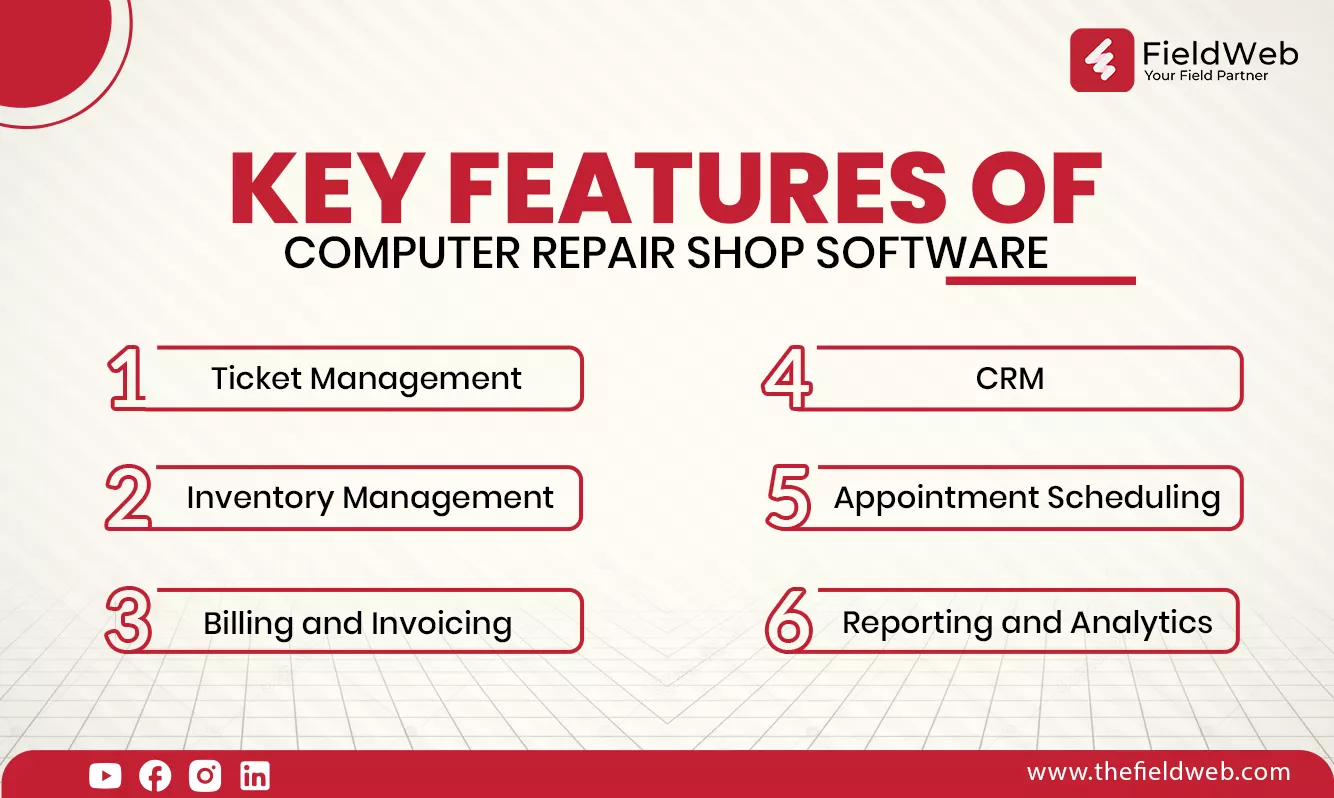
An efficient ticket management system is crucial for tracking repair requests and ensuring timely service. Automated ticketing helps manage workflow by assigning tasks to the appropriate technicians, setting priorities based on the urgency and complexity of the repair, and notifying both technicians and customers about the status of their repairs. This system ensures that no repair request falls through the cracks, enabling technicians to focus on their work without the distraction of manual tracking. Additionally, it provides a clear history of each repair, which can be invaluable for troubleshooting recurring issues and maintaining high service standards.
2. Inventory ManagementMaintaining an accurate inventory is essential for any repair shop. The software helps track parts, supplies, and equipment, ensuring you have what you need on hand and avoiding delays caused by out-of-stock items. Advanced inventory management features include real-time updates on stock levels, automated reordering when inventory runs low, and tracking of inventory usage trends. This not only helps in reducing downtime and improving service speed but also aids in cost management by preventing overstocking and wastage. Moreover, it can provide insights into which parts are used most frequently, helping in better forecasting and inventory planning.
3. Billing and InvoicingSimplify your financial processes with automated billing and invoicing. This feature ensures accurate charges for services and parts, generates professional invoices and integrates with payment gateways for smooth transactions. Automated billing eliminates manual errors and discrepancies, ensuring customers are billed correctly and promptly. The software can also handle various payment methods, track outstanding payments, and send reminders to customers for overdue invoices. Additionally, detailed billing records help maintain financial transparency and can be easily accessed for accounting and auditing purposes.
4. Customer Relationship Management (CRM)CRM tools help manage customer information, communication history, and service records. This enables personalized service, follow-ups, and building long-term customer relationships. With CRM, you can track every interaction with customers, including inquiries, complaints, and feedback. This information helps in tailoring your services to meet individual customer needs and preferences. Moreover, CRM systems often include marketing tools, allowing you to send targeted promotions, reminders for regular maintenance, and updates about new services or products. Building strong customer relationships through effective CRM can lead to increased customer loyalty and repeat business.
5. Appointment SchedulingEfficiently manage your time and resources with appointment scheduling features. Customers can book services online at their convenience, and the system sends automated reminders to reduce no-shows and optimize your schedule. This feature helps balance the workload among technicians, preventing overbooking, and ensuring that each job is given the attention it needs. Additionally, it can sync with your calendar and other scheduling tools, providing a unified view of all appointments and allowing for easy rescheduling and cancellations. By streamlining the appointment process, you can enhance customer experience and improve operational efficiency.
6. Reporting and AnalyticsGain insights into your business with comprehensive reporting and analytics. Track performance metrics such as average repair time, customer satisfaction rates, and revenue generated from different services. Identify trends in repair requests and inventory usage to make informed decisions that drive growth and efficiency. Advanced analytics can also highlight areas needing improvement, such as recurring issues with specific devices or bottlenecks in the repair process. By leveraging these insights, you can implement strategies to enhance service quality, increase profitability, and achieve long-term business goals. Reporting tools also help in setting benchmarks and measuring progress against your business objectives.
Integration with Other ToolsThe ability to integrate with accounting software, payment gateways, and other business tools ensures seamless operations and a unified system for managing all aspects of your business.
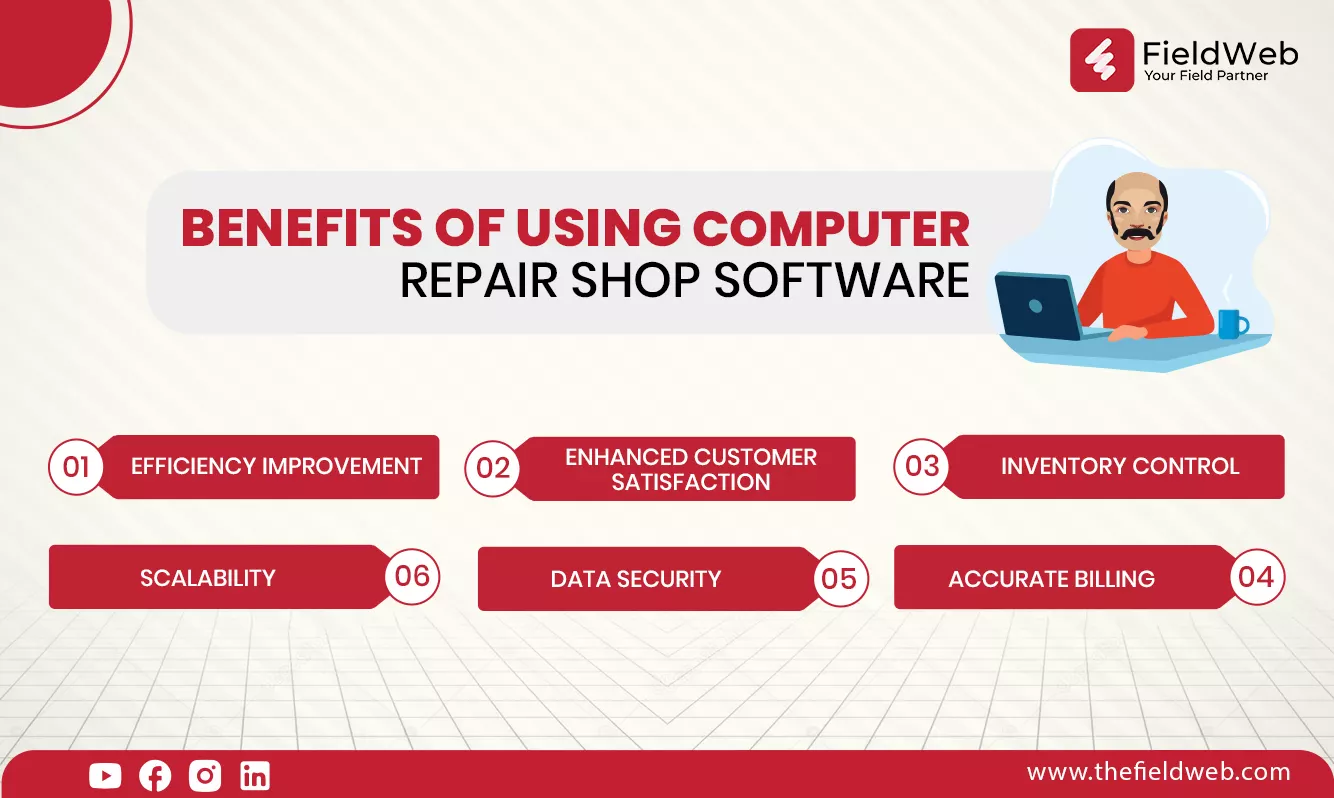
Automating routine tasks and streamlining workflows significantly reduces manual effort, allowing your team to focus on more critical aspects of the business. Instead of getting bogged down with paperwork and manual data entry, technicians can concentrate on diagnosing and repairing devices. This efficiency boost not only speeds up the repair process but also reduces the likelihood of human error. Additionally, features like automated ticketing, inventory updates, and scheduling free up valuable time, enabling your team to handle more repairs and increase overall productivity.
2. Enhanced Customer SatisfactionWith organized processes and timely updates, customers enjoy a better service experience, leading to higher satisfaction and loyalty. When customers receive prompt notifications about the status of their repairs and accurate estimates of repair times and costs, it builds trust and transparency. Personalized communication, such as follow-ups and feedback requests, shows customers that their business is valued. This level of service often translates to positive reviews and repeat business, as satisfied customers are more likely to recommend your repair shop to others.
3. Inventory ControlAccurate inventory management prevents stockouts and overstock situations, ensuring you have the right parts when needed and reducing unnecessary costs. By keeping track of parts in real time and setting automated reorder points, you can maintain optimal inventory levels. This means less money tied up in excess stock and fewer delays waiting for parts to arrive. For computer repair shops, having the necessary parts on hand is crucial for quick turnarounds and customer satisfaction. Efficient inventory management also helps in identifying trends in parts usage, allowing for better planning and procurement strategies.
4. Accurate BillingAutomated billing processes minimize errors and ensure precise invoicing, enhancing financial accuracy and customer trust. When customers are billed correctly for the services rendered and parts used, it eliminates disputes and ensures a smooth payment process. The software can handle various pricing models, discounts, and promotions, ensuring that all financial transactions are transparent and correctly documented. This level of accuracy not only improves cash flow but also enhances your shop’s credibility and professionalism in the eyes of your customers.
5. Data SecurityProtecting customer data and business information is paramount. Reliable software ensures data security through encryption and regular backups. In a computer repair shop, sensitive information such as customer contact details, payment information, and repair history must be safeguarded against breaches and data loss. The software’s robust security measures ensure that all data is stored securely and is accessible only to authorized personnel. Regular backups mean that even in the event of a system failure, data can be quickly restored, minimizing disruption to your business operations.
6. ScalabilityGAs your business grows, the software can scale with you, accommodating increased demand and additional features without a hitch. Whether you're expanding to multiple locations, increasing your service offerings, or handling a larger customer base, scalable software adapts to your needs. This flexibility means you won’t have to switch systems as your business evolves, saving you time and resources. Scalable solutions also allow for the integration of new technologies and features, ensuring that your repair shop stays ahead of industry trends and continues to provide top-notch service.
By leveraging the right computer repair shop software, you can enhance operational efficiency, boost customer satisfaction, maintain tight inventory control, ensure accurate billing, protect sensitive data, and support business growth. These benefits collectively contribute to a more streamlined, professional, and successful repair shop.
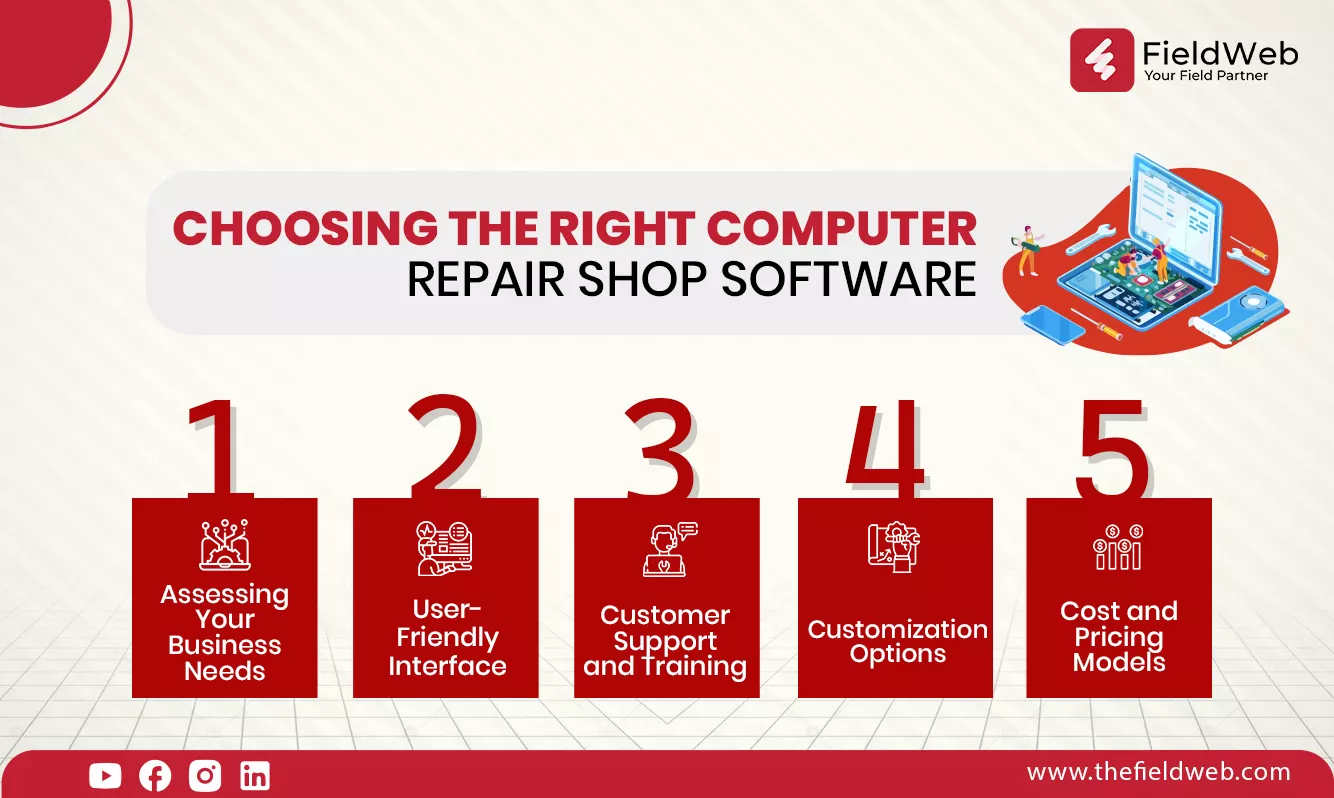
Start by identifying your specific requirements. What features are most important to you? Consider the size of your business, the volume of repairs, and any unique needs you may have. For instance, a small repair shop may prioritize basic ticket management and billing, while a larger operation might need advanced inventory control and CRM capabilities. Think about your current pain points—whether it's managing a high volume of repairs, keeping track of parts, or communicating with customers—and look for software that addresses these issues effectively. The right software should align with your business goals and streamline your daily operations.
2. User-Friendly InterfaceA user-friendly interface is crucial for ease of use. Ensure the software is intuitive and easy to navigate, minimizing the learning curve for your staff. In a busy repair shop, you don't have time to train your team extensively on a complex system. The software should have a clean, straightforward layout, with all essential features easily accessible. Look for drag-and-drop functionality, clear labels, and helpful tooltips that guide users through tasks. A well-designed interface boosts productivity and reduces the chances of errors, helping your team focus on providing excellent service.
3. Customer Support and TrainingGood customer support and training are essential. Ensure the provider offers adequate support and resources to help you get the most out of the software. This includes comprehensive training sessions during the onboarding process, as well as ongoing support through various channels like phone, email, and live chat. Check if there are detailed user manuals, video tutorials, and FAQs available. Quick and efficient customer support can make a significant difference when you encounter issues or need help with specific features, ensuring minimal disruption to your business operations.
4. Customization OptionsEvery business is unique. Look for software that offers customization options to tailor the system to your specific processes and requirements. This might include customizable fields in the ticketing system, personalized templates for invoices and reports, and flexible workflows that match your shop's operations. The ability to add or remove features based on your evolving needs can save you time and increase efficiency. For example, if you specialize in specific types of repairs or offer unique services, customizable software can help you manage these aspects seamlessly, giving you a competitive edge.
5. Cost and Pricing ModelsUnderstand the different pricing structures available. Consider not only the initial cost but also ongoing fees, such as subscription rates or additional charges for extra features. Some software providers offer tiered pricing plans based on the number of users, features included, or the level of support provided. Be sure to factor in these costs when budgeting for your software investment. Additionally, look for any hidden fees, such as charges for updates or additional storage. Evaluate the return on investment by considering how the software will save you time, reduce errors, and potentially increase your revenue through improved efficiency and customer satisfaction.
By thoroughly evaluating your business needs, ensuring the software is user-friendly, securing reliable customer support, seeking customization options, and understanding the cost implications, you can choose the best computer repair shop software for your business. This thoughtful approach will help you find a solution that not only meets your current requirements but also supports your long-term growth and success.
Choosing the right software for your computer repair shop is crucial to streamline operations, improve customer satisfaction, and grow your business. Here, we provide an overview and comparison of some top software solutions available in the market, including RepairShopr, Fixably, ServiceDesk, and FieldWeb. Each of these solutions offers unique features and pricing models, so understanding their differences can help you make an informed decision.

Overview: FieldWeb is an emerging software solution designed to meet the needs of computer repair shops. It offers a blend of essential features to streamline operations and improve customer engagement, making it a standout choice for businesses looking to enhance their efficiency and service quality.
Key Features:Pricing: FieldWeb provides competitive pricing plans tailored to different business sizes. They offer a free trial, allowing you to experience the software’s benefits before committing. This flexibility makes FieldWeb an accessible option for both small and mid-sized repair shops.
User Reviews: FieldWeb is praised for its simplicity and efficiency. Users find it particularly beneficial for its straightforward interface and responsive customer service. Many have highlighted how it has helped them streamline their operations and improve customer satisfaction, making it an excellent choice for growing repair shops.
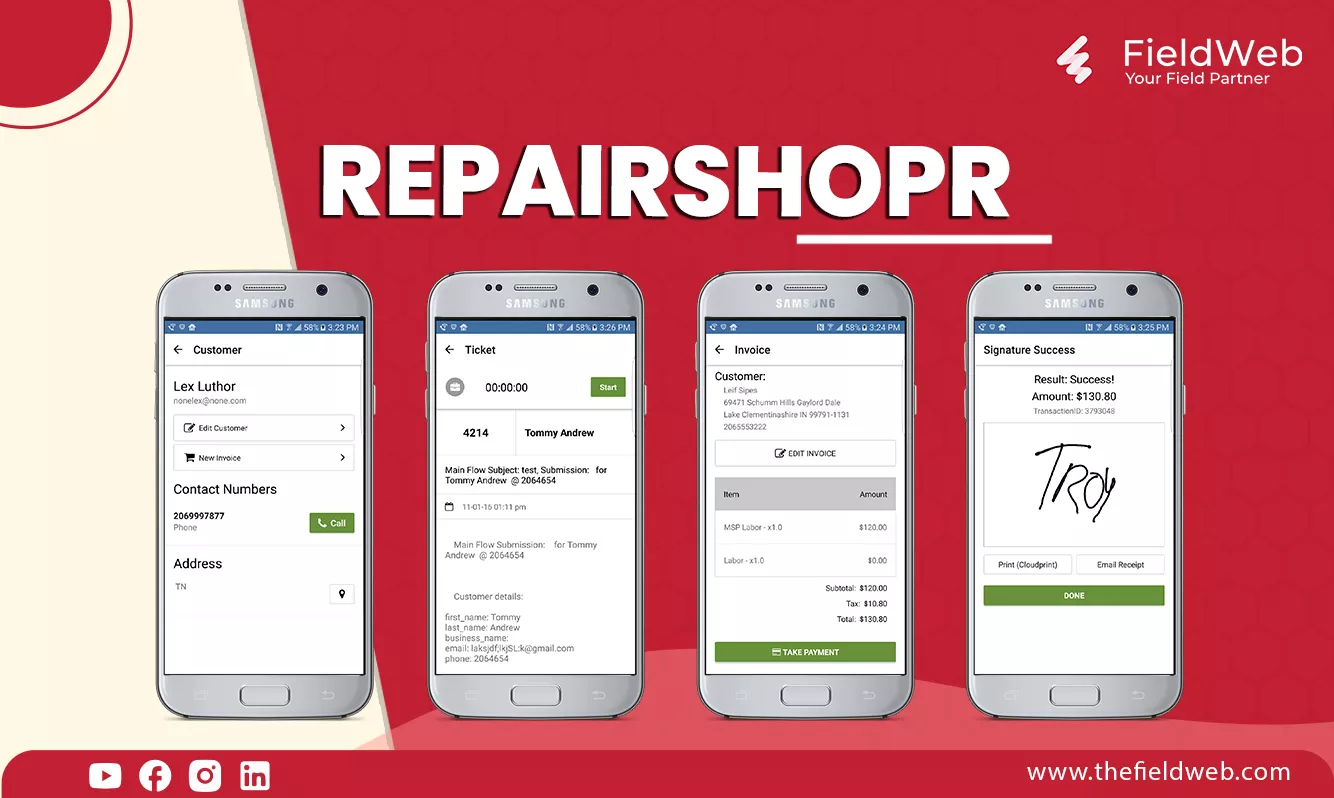
Overview: RepairShopr is a comprehensive software designed specifically for repair shops, including computer repair services. It offers a wide range of features such as ticket management, CRM, invoicing, inventory management, and marketing tools.
Key Features:Pricing: RepairShopr offers tiered pricing plans based on the number of users and included features. Plans start with basic functionality and scale up to include more advanced features, providing flexibility to match your business needs.
User Reviews: Generally positive, with users praising its robust feature set and ease of use. Some users have noted that the extensive features can have a learning curve, but overall, it’s highly regarded for its comprehensive capabilities.

Overview: Fixably is another popular software solution tailored for computer repair shops. It emphasizes streamlining repair processes and improving customer communication.
Key Features:Pricing: Fixably offers a flexible pricing model based on the specific needs and size of your business. Custom quotes are available to ensure the best fit for your operations, providing a tailored approach to pricing.
User Reviews: Users appreciate Fixably’s intuitive interface and excellent customer support. It’s noted for its strong inventory management capabilities and detailed tracking features, making it a reliable choice for busy repair shops.
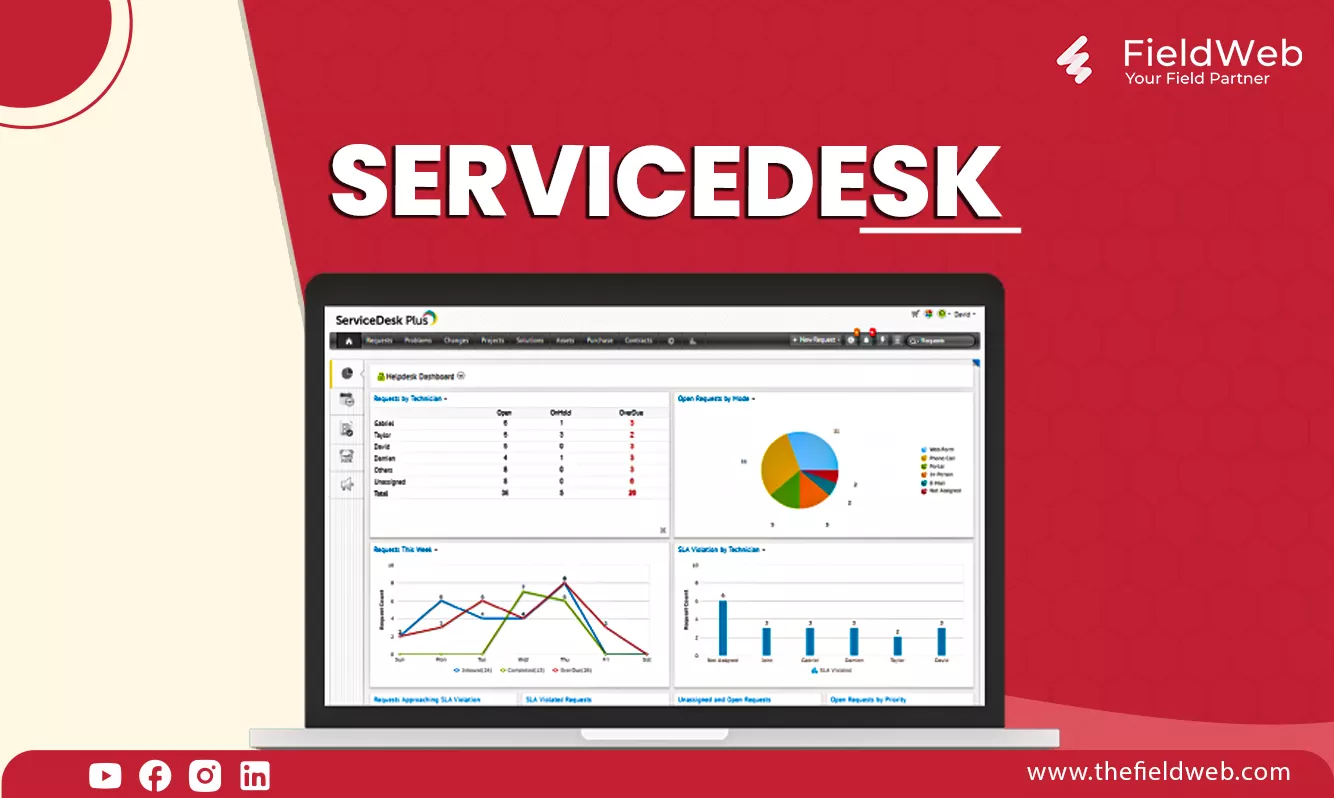
Overview: ServiceDesk is a versatile software solution that caters to various repair industries, including computer repair. It focuses on enhancing workflow efficiency and customer satisfaction.
Key Features:Pricing: ServiceDesk offers subscription-based pricing with different tiers to match the size and requirements of your business. This allows for scalability as your business grows, ensuring you can always meet demand.
User Reviews: Highly rated for its user-friendly interface and comprehensive feature set. Users also commend its scalability and the responsiveness of its customer support team, making it a strong contender for growing repair shops.
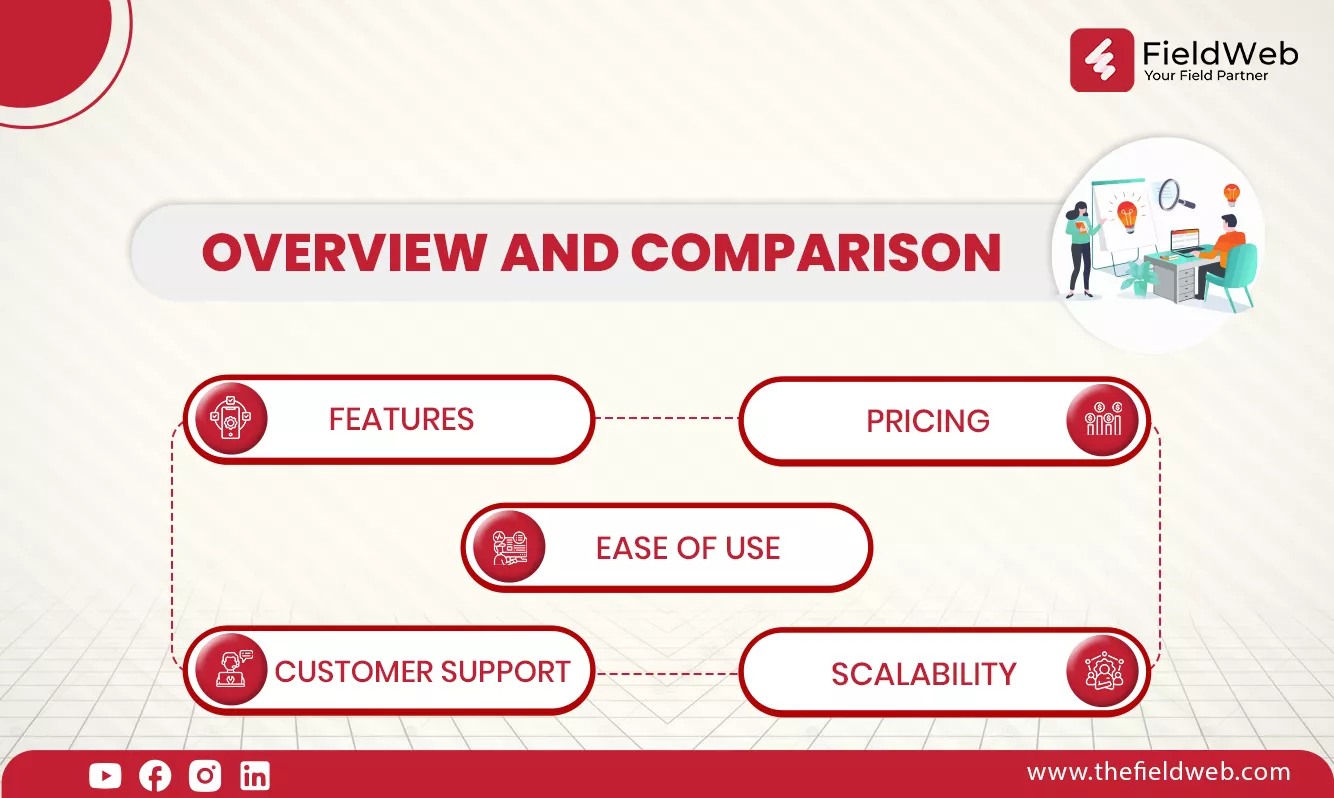
When comparing these software solutions, consider the following aspects:
By carefully evaluating these factors and reviewing user feedback, you can select the computer repair shop software that best aligns with your business needs and goals. FieldWeb, with its balanced feature set and customer-centric design, emerges as a particularly strong choice for shops looking to optimize their operations and deliver exceptional service.
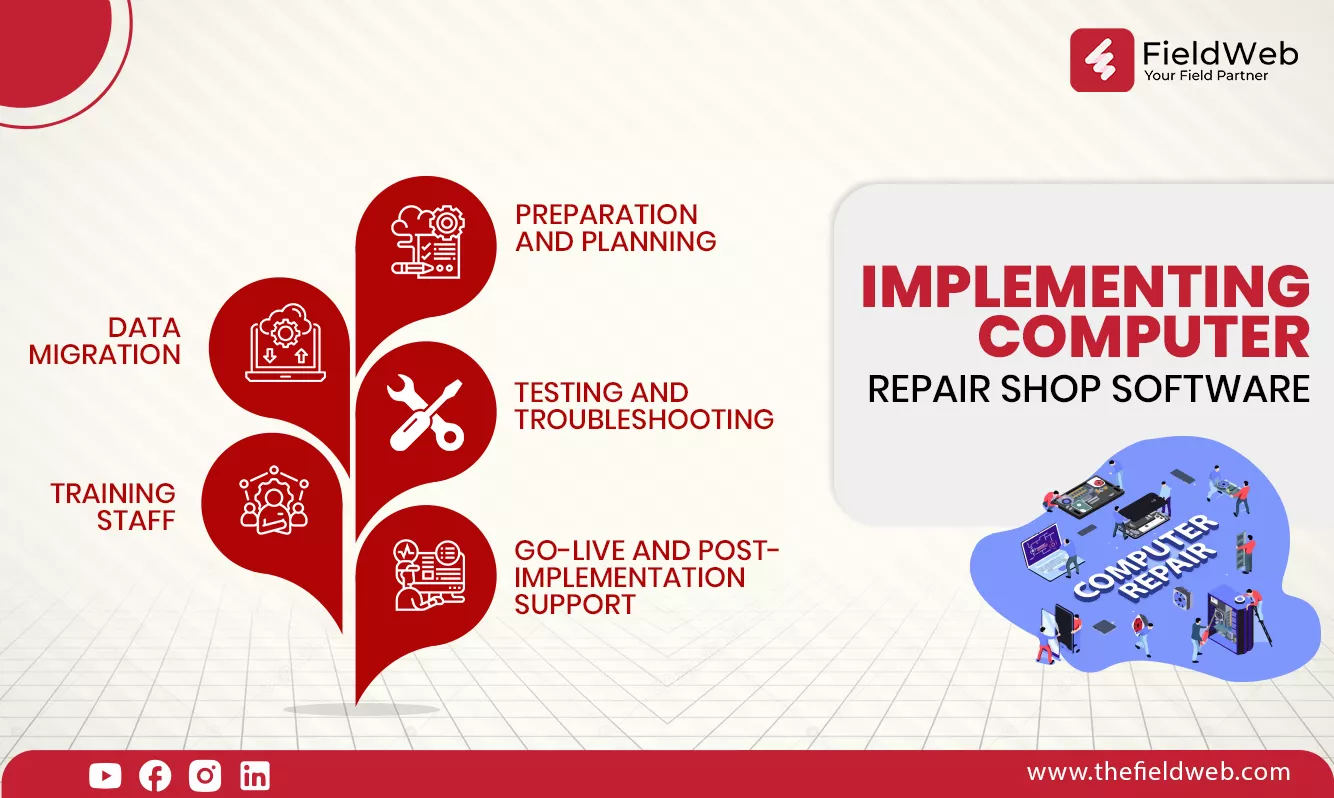
Prepare for implementation by assessing your current processes and planning the transition. Set clear goals and timelines to ensure a smooth rollout. Start by evaluating your current workflows, identifying inefficiencies, and determining how the new software can address these issues. Create a detailed implementation plan that includes specific milestones, responsible team members, and deadlines. Engage all stakeholders in the planning process to ensure everyone understands the objectives and their roles in the transition. Effective preparation minimizes disruptions and sets the stage for a successful implementation.
2. Data MigrationMigrating existing data to the new system can be challenging. Plan this process carefully to ensure all important information is transferred accurately and securely. Begin by conducting a data audit to identify what needs to be migrated, such as customer records, repair histories, inventory data, and financial information. Cleanse the data to remove duplicates and outdated entries. Use data migration tools provided by the software vendor or third-party solutions to facilitate the transfer. Ensure data is encrypted during the migration to protect sensitive information. Perform multiple test migrations to identify and resolve any issues before the final transfer.
3. Training StaffProper training is essential for successful implementation. Ensure all employees are proficient with the new software and understand how to use its features effectively. Develop a comprehensive training program that includes hands-on sessions, tutorials, and reference materials. Tailor the training to different roles within your shop, ensuring technicians, front-desk staff, and managers understand how to use the software for their specific tasks. Consider using a combination of in-person training, webinars, and online resources to accommodate different learning styles. Continuous training and refreshers will help maintain proficiency and adapt to new features or updates.
4. Testing and TroubleshootingConduct thorough testing before going live. Identify and resolve any issues to ensure the software functions as expected. Create a testing plan that covers all critical aspects of your operations, including ticket management, inventory tracking, billing, and customer communications. Use real-world scenarios to test the software’s performance and identify any gaps or bugs. Involve end-users in the testing process to gather feedback and ensure the software meets their needs. Establish a troubleshooting protocol to address issues promptly, and work closely with the software vendor’s support team to resolve any technical problems.
5. Go-Live and Post-Implementation SupportOnce you're ready, go live with the new system. Continue to provide support and training as needed to ensure ongoing success. Plan a phased rollout to manage the transition smoothly, starting with a pilot phase if possible. Monitor the system closely during the initial go-live period to address any issues that arise. Provide ongoing support to your team through regular check-ins, a dedicated help desk, and additional training sessions. Gather feedback from staff and customers to identify areas for improvement. Regularly review and optimize the software’s use to ensure it continues to meet your business needs and supports your growth.
By following these steps, you can ensure a smooth and successful implementation of your computer repair shop software, leading to enhanced efficiency, improved customer satisfaction, and a stronger overall business.
Implementing the right computer repair shop software can transform your business operations, enhancing efficiency, customer satisfaction, and overall profitability. From robust ticket management and real-time inventory tracking to seamless billing and comprehensive CRM capabilities, these tools are designed to streamline your workflow and support your growth.
By carefully assessing your business needs, comparing top software solutions, and planning a detailed implementation strategy, you can select and integrate the software that best aligns with your objectives. FieldWeb stands out as a particularly strong option, offering a user-friendly interface, responsive customer support, and competitive pricing, making it an excellent choice for small to mid-sized repair shops.
Investing in the right software and ensuring a smooth implementation process will position your repair shop for long-term success. With the right tools at your disposal, you can focus on what you do best—providing exceptional service and building lasting relationships with your customers.
Call to ActionReady to take your computer repair shop to the next level? Try FieldWeb today and experience the difference firsthand. With our intuitive interface, comprehensive features, and responsive customer support, you'll streamline your operations and delight your customers like never before.
Book Demo and see how FieldWeb can transform your business!
OUR POWERFUL FEATURES